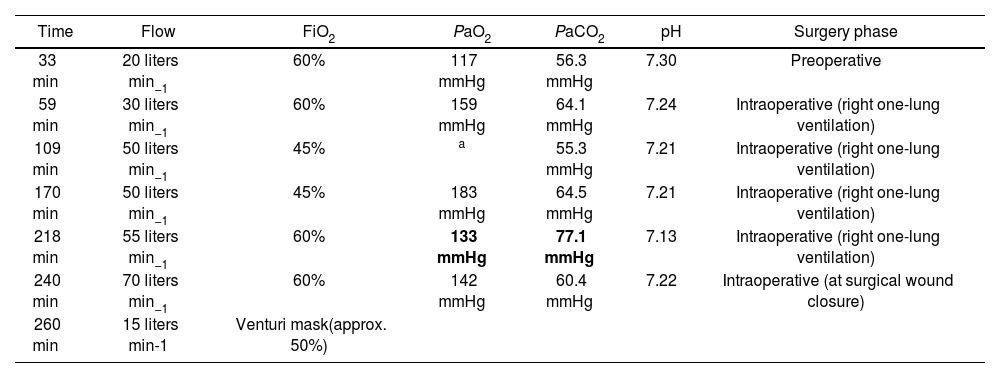Tubeless anaesthesia has become widespread in videothoracoscopic surgery, even in major procedures such as lobectomies. There are several advantages in avoiding general anaesthesia and one-lung mechanical ventilation, such as faster recovery and shorter hospital stays. However, hypoxaemia and hypercapnia are the most reported causes of conversion to general anaesthesia. High Flow Oxygen Therapy (HFOT) generates flow-dependent positive end-expiratory pressure, improves oxygenation and also carbon dioxide washout by flow-dependent dead space flushing. For this reason, intraoperative HFOT may reduce the rate of conversion to general anaesthesia. We report our experience with intraoperative HFOT in a 71-year-old female with lung adenocarcinoma undergoing VATS upper left lobectomy.
La anestesia sin intubación se ha generalizado en la cirugía videotoracoscópica, incluso en procedimientos mayores tales como lobectomías. Existen diversas ventajas al evitar la anestesia general y la ventilación mecánica unipulmonar, tales como una recuperación más rápida y una menor estancia hospitalaria. Si embargo, la hipoxemia y la hipercapnia son las causas más reportadas de conversión a anestesia general. La oxigenoterapia de alto flujo (OAF) genera presión al final de la espiración positiva y dependiente del flujo, mejora la oxigenación y el lavado de dióxido de carbono, mediante el enjuague del espacio muerto dependiente del flujo. Por tal motivo, la OAF intraoperatoria puede reducir la tasa de conversión a anestesia general. Reportamos nuestra experiencia con OAF en una mujer de 71 años con adenocarcinoma de pulmón sometida a lobectomía superior izquierda mediante VATS.








